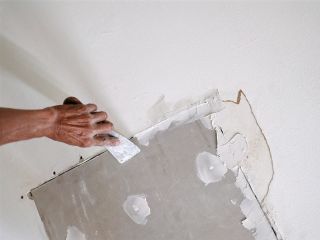
Drywall repairs are an essential part of home maintenance, whether you're dealing with small cracks or larger holes. Using the right techniques ensures a seamless finish that blends perfectly with your existing walls or ceilings. In this guide, we’ll explore the most effective drywall repair methods, materials, and tools to help you achieve professional results.
Common Drywall Patch Methods
1. Strapped Backing Patch Repair
This technique is ideal for medium to large holes in drywall, especially in ceilings. It involves using a short metal stud or a 2x1-inch wood strap as backing for the patch. The strap is placed behind the hole, extending beyond its edges, and secured to the drywall. The patch is then screwed onto this backing, providing a sturdy foundation for repairs.
2. Hammock (Ohio Drywall) Patching
The hammock method is versatile and suitable for small to medium holes (up to 13 inches). It doesn’t require the hole to be square or rectangular, making it ideal for irregular shapes. If you’ve cut out a section of drywall, you can reuse it as a patch with this method. However, it’s not recommended for ceiling repairs due to its lack of structural support.
3. California (Butterfly) Patch
This method is perfect for small holes and works well for covering unused outlet holes or other square openings. A piece of drywall is cut slightly larger than the hole, with the paper backing left intact around the edges to act as tape. This technique is quick and effective but not suitable for ceilings.
Key Steps in Drywall Repair
1. Surface Preparation:
Clean the damaged area thoroughly by removing debris or loose drywall pieces. A clean surface ensures better adhesion of patches and compounds.
2. Cutting & Backing:
For larger holes, cut back to the nearest stud to create a clean edge. Insert backing material like wood or metal straps behind the hole for support.
3. Patching & Taping:
Use joint tape or mesh tape over seams to reinforce the repair area. Apply joint compound in thin layers over the patch, feathering the edges for a smooth transition.
4. Sanding & Finishing:
Once dry, sand the area lightly with fine-grit sandpaper to remove imperfections. Finish with primer and paint to match the surrounding wall.
Pro Tips for Seamless Results
- Always apply joint compound in thin layers to avoid uneven surfaces and long drying times.
- Use lightweight joint compound for easier sanding on final coats.
- Feather edges carefully when applying compound or primer to blend repairs seamlessly.
- For ceilings, ensure patches are reinforced with sturdy backing to prevent sagging.
In Conclusion
Ready to tackle your drywall repairs? Whether it’s a small crack or a large hole, using these expert techniques will ensure flawless results every time! For more detailed guidance on drywall repair and maintenance tips, visit FEMA’s Drywall Repair Guidelines – a trusted resource for home improvement safety and best practices.
Looking for professional assistance? Contact us today at Drywall Repair Whittier! Our skilled technicians are here to help with all your drywall needs—call now or schedule an appointment online!

